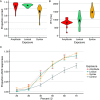Lexically guided perceptual learning is robust to task-based changes in listening strategy
- PMID: 30180678
- PMCID: PMC6117182
- DOI: 10.1121/1.5047672
Lexically guided perceptual learning is robust to task-based changes in listening strategy
Abstract
Listeners use lexical information to resolve ambiguity in the speech signal, resulting in the restructuring of speech sound categories. Recent findings suggest that lexically guided perceptual learning is attenuated when listeners use a perception-focused listening strategy (that directs attention towards surface variation) compared to when listeners use a comprehension-focused listening strategy (that directs attention towards higher-level linguistic information). However, previous investigations used the word position of the ambiguity to manipulate listening strategy, raising the possibility that attenuated learning reflected decreased strength of lexical recruitment instead of a perception-oriented listening strategy. The current work tests this hypothesis. Listeners completed an exposure phase followed by a test phase. During exposure, listeners heard an ambiguous fricative embedded in word-medial lexical contexts that supported realization of the ambiguity as /∫/. At test, listeners categorized members of an /ɑsi/-/ɑ∫i/ continuum. Listening strategy was manipulated via exposure task (experiment 1) and explicit acknowledgement of the ambiguity (experiment 2). Compared to control participants, listeners who were exposed to the ambiguity showed more /∫/ responses at the test; critically, the magnitude of learning did not differ across listening strategy conditions. These results suggest that given sufficient lexical context, lexically guided perceptual learning is robust to task-based changes in listening strategy.
Figures


References
-
- Bates, D. , Maechler, M. , Bolker, B. , and Walker, S. (2015). “Fitting linear mixed-effects models using lme4,” J. Stat. Soft. 67(1), 1–48.10.18637/jss.v067.i01 - DOI
-
- Craik, F. I. , and Tulving, E. (1975). “Depth of processing and the retention of words in episodic memory,” J. Exp. Psychol. Gen. 104(3), 268–294.10.1037/0096-3445.104.3.268 - DOI
Publication types
MeSH terms
Grants and funding
LinkOut - more resources
Full Text Sources
Other Literature Sources

